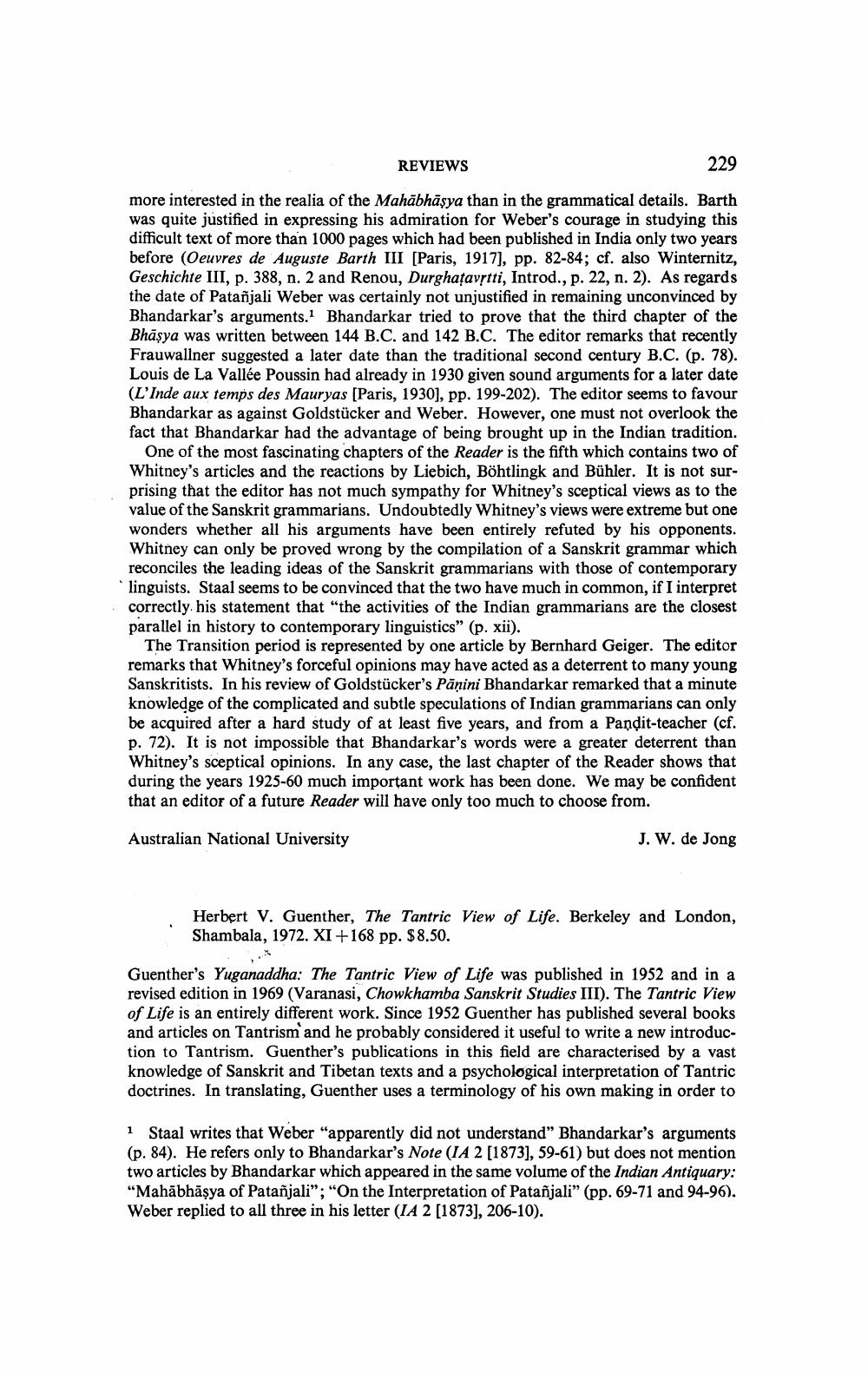Book Title: Reviews Of Different Books Author(s): Publisher: View full book textPage 5
________________ REVIEWS 229 more interested in the realia of the Mahabhasya than in the grammatical details. Barth was quite justified in expressing his admiration for Weber's courage in studying this difficult text of more than 1000 pages which had been published in India only two years before (Oeuvres de Auguste Barth III (Paris, 1917), pp. 82-84; cf. also Winternitz, Geschichte III, p. 388, n. 2 and Renou, Durghatavstti, Introd., p. 22, n. 2). As regards the date of Patanjali Weber was certainly not unjustified in remaining unconvinced by Bhandarkar's arguments. Bhandarkar tried to prove that the third chapter of the Bhasya was written between 144 B.C. and 142 B.C. The editor remarks that recently Frauwallner suggested a later date than the traditional second century B.C. (p. 78). Louis de La Vallee Poussin had already in 1930 given sound arguments for a later date (L'Inde aux temps des Mauryas (Paris, 1930), pp. 199-202). The editor seems to favour Bhandarkar as against Goldstucker and Weber. However, one must not overlook the fact that Bhandarkar had the advantage of being brought up in the Indian tradition. One of the most fascinating chapters of the Reader is the fifth which contains two of Whitney's articles and the reactions by Liebich, Bohtlingk and Buhler. It is not surprising that the editor has not much sympathy for Whitney's sceptical views as to the value of the Sanskrit grammarians. Undoubtedly Whitney's views were extreme but one wonders whether all his arguments have been entirely refuted by his opponents. Whitney can only be proved wrong by the compilation of a Sanskrit grammar which reconciles the leading ideas of the Sanskrit grammarians with those of contemporary linguists. Staal seems to be convinced that the two have much in common, if I interpret correctly. his statement that "the activities of the Indian grammarians are the closest parallel in history to contemporary linguistics" (p. xii). The Transition period is represented by one article by Bernhard Geiger. The editor remarks that Whitney's forceful opinions may have acted as a deterrent to many young Sanskritists. In his review of Goldstucker's Panini Bhandarkar remarked that a minute knowledge of the complicated and subtle speculations of Indian grammarians can only be acquired after a hard study of at least five years, and from a Pandit-teacher (cf. p. 72). It is not impossible that Bhandarkar's words were a greater deterrent than Whitney's sceptical opinions. In any case, the last chapter of the Reader shows that during the years 1925-60 much important work has been done. We may be confident that an editor of a future Reader will have only too much to choose from. Australian National University J. W. de Jong Herbert V. Guenther, The Tantric View of Life. Berkeley and London, Shambala, 1972. XI +168 pp. $8.50. Guenther's Yuganaddha: The Tantric View of Life was published in 1952 and in a revised edition in 1969 (Varanasi, Chowkhamba Sanskrit Studies III). The Tantric View of Life is an entirely different work. Since 1952 Guenther has published several books and articles on Tantrism and he probably considered it useful to write a new introduction to Tantrism. Guenther's publications in this field are characterised by a vast knowledge of Sanskrit and Tibetan texts and a psychological interpretation of Tantric doctrines. In translating, Guenther uses a terminology of his own making in order to 1 Staal writes that Weber "apparently did not understand" Bhandarkar's arguments (p. 84). He refers only to Bhandarkar's Note (IA 2 [1873], 59-61) but does not mention two articles by Bhandarkar which appeared in the same volume of the Indian Antiquary: "Mahabhasya of Patanjali"; "On the Interpretation of Patanjali" (pp. 69-71 and 94-96). Weber replied to all three in his letter (IA 2 (1873), 206-10).Page Navigation
1 ... 3 4 5 6 7 8 9 10 11 12 13 14 15 16
